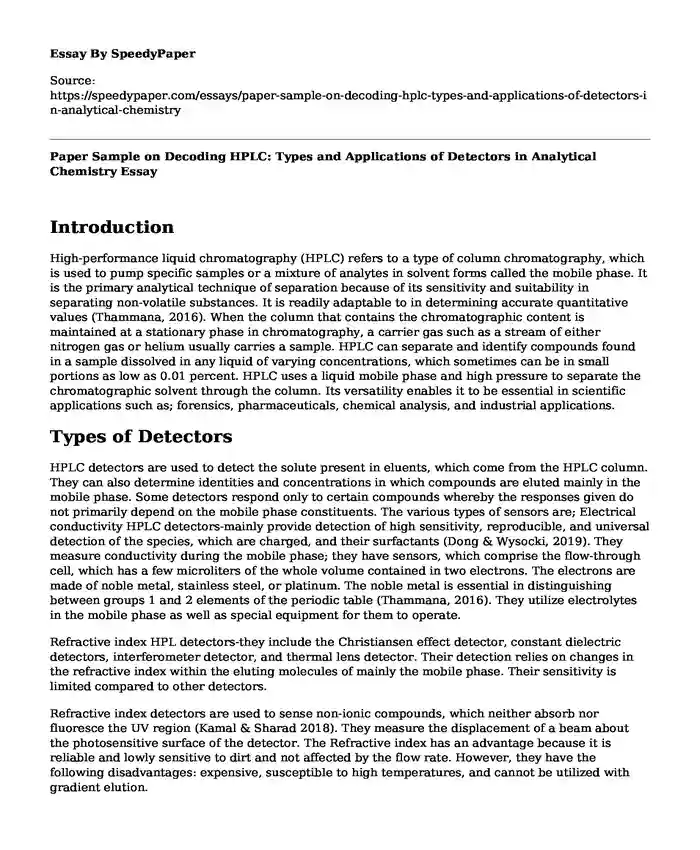Introduction
High-performance liquid chromatography (HPLC) refers to a type of column chromatography, which is used to pump specific samples or a mixture of analytes in solvent forms called the mobile phase. It is the primary analytical technique of separation because of its sensitivity and suitability in separating non-volatile substances. It is readily adaptable to in determining accurate quantitative values (Thammana, 2016). When the column that contains the chromatographic content is maintained at a stationary phase in chromatography, a carrier gas such as a stream of either nitrogen gas or helium usually carries a sample. HPLC can separate and identify compounds found in a sample dissolved in any liquid of varying concentrations, which sometimes can be in small portions as low as 0.01 percent. HPLC uses a liquid mobile phase and high pressure to separate the chromatographic solvent through the column. Its versatility enables it to be essential in scientific applications such as; forensics, pharmaceuticals, chemical analysis, and industrial applications.
Types of Detectors
HPLC detectors are used to detect the solute present in eluents, which come from the HPLC column. They can also determine identities and concentrations in which compounds are eluted mainly in the mobile phase. Some detectors respond only to certain compounds whereby the responses given do not primarily depend on the mobile phase constituents. The various types of sensors are; Electrical conductivity HPLC detectors-mainly provide detection of high sensitivity, reproducible, and universal detection of the species, which are charged, and their surfactants (Dong & Wysocki, 2019). They measure conductivity during the mobile phase; they have sensors, which comprise the flow-through cell, which has a few microliters of the whole volume contained in two electrons. The electrons are made of noble metal, stainless steel, or platinum. The noble metal is essential in distinguishing between groups 1 and 2 elements of the periodic table (Thammana, 2016). They utilize electrolytes in the mobile phase as well as special equipment for them to operate.
Refractive index HPL detectors-they include the Christiansen effect detector, constant dielectric detectors, interferometer detector, and thermal lens detector. Their detection relies on changes in the refractive index within the eluting molecules of mainly the mobile phase. Their sensitivity is limited compared to other detectors.
Refractive index detectors are used to sense non-ionic compounds, which neither absorb nor fluoresce the UV region (Kamal & Sharad 2018). They measure the displacement of a beam about the photosensitive surface of the detector. The Refractive index has an advantage because it is reliable and lowly sensitive to dirt and not affected by the flow rate. However, they have the following disadvantages: expensive, susceptible to high temperatures, and cannot be utilized with gradient elution.
UV/VIS HPLC detectors are highly used because of their specific response to particular compounds based on the eluting molecules' functional groups, which absorb light. One shortcoming of UV/VIS HPLC is that they do not work with compounds that do not absorb light at the region-provided wavelength. They detect given classes of certain compounds due to their high sensitivity.
Conclusion
The primary technical analysis used when testing for the presence of drug molecules in compounds is reversed-phase HPLC. One constraint that significantly affects a UV-visible detector is the inability to develop adequate sensitivity and selectivity for analytes that do not have the expected UV chromophore. The sensitivity of detectors does not mainly depend on how specific their functions are in the analytes. It depends on different functionalities such as differences in volatility, and instability, which brings about differences in their output.
References
Thammana, M. (2016). A review of high-performance liquid chromatography (HPLC). Res Rev J Pharm Anal RRJPA, 5(2), 22-28. https://www.semanticscholar.org/paper/A-Review-on-High-Performance-Liquid-Chromatography-Thammana/ae437aeb0a2ed9ba79230ca34211a1e2253ae0e1?p2df
Dong, M. W., & Wysocki, J. (2019). Ultraviolet detectors: Perspectives, principles, and practices. Lc Gc North America, 37, 750-759. https://www.researchgate.net/profile/Michael_Dong6/publication/342902061_franksteinerthermofishercom/links/5f0ca66e299bf10744533f69/franksteinerthermofishercom.pdf
Kamal, S., & Sharad, W. (2018). Step-up in liquid chromatography from HPLC to UPLC: A comparative and comprehensive review. The Pharma Innovation Journal, 7, 342-347. http://www.thepharmajournal.com/archives/2018/vol7issue8/PartF/7-8-17-791.pdf
Cite this page
Paper Sample on Decoding HPLC: Types and Applications of Detectors in Analytical Chemistry. (2024, Jan 08). Retrieved from https://speedypaper.net/essays/paper-sample-on-decoding-hplc-types-and-applications-of-detectors-in-analytical-chemistry
Request Removal
If you are the original author of this essay and no longer wish to have it published on the SpeedyPaper website, please click below to request its removal:
- Essay Sample Analyzing the Failure of the REACH Project
- Essay Sample Describing Weather History and Geology of Pali Hawaii
- Paper Example on Teen Pregnancy
- Article Analysis Essay on "Why Rural America Voted for Trump" by Robert Leonard
- Free Essay. ACE Star Model of Knowledge Transformation
- Essay Example: The Importance of the Cash Flow Statement (Lockheed Martin)
- Unveiling the Genetic Landscape: The Dominant Role of NCAN Gene in Bipolar Disorder - Essay Sample
Popular categories





